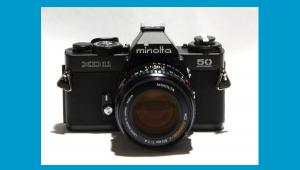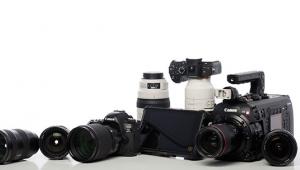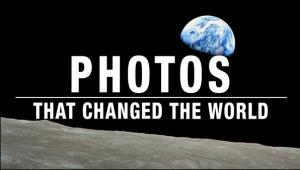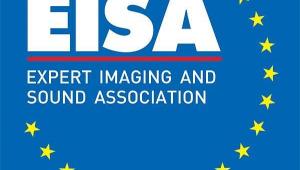Canon's New EOS Digital Rebel XTi SLR
This new EOS Digital Rebel XTi SLR has a 10.1 megapixel resolution; refined and redesigned Canon CMOS sensor; larger, easier to read 2.5 inch display screen (along with simplified and streamlined menu navigation), and the EOS Integrated Cleaning System, a self-cleaning image sensor unit/dust removal system.

Other imaging improvements include Canon's fast, high-precision 9-point
autofocus system and a new maximum burst rate in large/fine and raw quality
modes that -- at three frames per second -- is double the capability
of the Digital Rebel XT SLR.
At the heart of the Rebel XTi SLR's high-resolution image capability is
its large, single plate, CMOS color image sensor. Designed and manufactured
by Canon specifically for the Rebel XTi SLR, this sensor's 10.1 million
pixels are fractionally smaller than the pixels in the 8 megapixel Rebel XT
model, yet are claimed to deliver markedly improved resolution, enabling the
sensor to capture more image information. At 22.2 x 14.8 mm in size, this new
CMOS sensor maintains the 1.6x conversion ratio found on many other members
of the EOS Digital SLR line, including the Rebel XT and the EOS 30D models.
Canon CMOS sensors are claimed to significantly reduce image noise levels by converting light values to electrical signals on the chip rather than having them converted elsewhere in the camera. The Rebel XTi SLR's CMOS sensor goes further still, maintaining an exceptional dynamic range while reducing the noise level that one might typically expect for a pixel size delivering such high resolution. Canon engineers and designers achieved this breakthrough in sensor design by reducing the space between the chip's microlenses while at the same time increasing the sensitivity of each photodiode. As a result, the camera achieves 20 percent greater resolution than an eight-megapixel sensor with comparable noise reduction and dynamic range.
The Digital Rebel XTi SLR also features a wide range of ISO settings (100 --1600)
with the ability to "float" to any intermediate step along that
range in fully automatic modes while allowing the user to set the ISO manually
at full step intervals in the camera's creative modes.
The EOS Integrated Cleaning System, available only on the EOS Rebel XTi camera
includes a number of factors. Canon claims to have gone out of its way to design
the XTi model to first create or attract no dust. Canon begins by minimizing
the dust and particles created by the camera itself, by reformulating the materials
used in the body cap and shutter to materials more resistant to particle "fall
out" due to normal use and wear. Canon also treats the camera's
low pass filter with an anti-static charge to prevent static-charged dust from
adhering to it.
Still, recognizing that humidity and a variety of real world conditions can cause dust to enter and adhere to the sensor or low pass filter despite the most scrupulous of efforts, Canon created the Self Cleaning Sensor Unit. The low pass filter on the front of the CMOS sensor is attached to an ultrasonic vibrating unit that literally shakes the loose dust particles off of the surface. The newly liberated dust is then captured by an adhesive material that keeps the particles from becoming airborne again once the camera moves.
The self cleaning sensor unit's ultrasonic anti-dust shake activates
automatically for one second whenever the camera is powered on or off, ensuring
that the camera will be as relatively dust free as possible and can be activated
at other times through a simple menu selection.
Despite the ingenuity behind the Self Cleaning Sensor Unit there are occasions
when dust particles of a stickier nature are not vibrated free of the low pass
filter. In these situations, the Dust Delete Data function can be engaged. Simply
put, by aiming the camera at a white wall or even a white piece of paper (or,
in a pinch, removing the lens from the camera) the Dust Delete Data function
will map the size and position of the dust particles remaining on the low pass
filter. Once the dust is "mapped", that information is attached
as metadata to all subsequently shot images regardless of recording format,
RAW or JPEG. When the images and appended dust data map are transferred to a
computer using the Rebel XTi's new Digital Photo Professional software,
the dust information can be subtracted from the images simply by selecting the
"apply dust delete data" option. Users can update the Dust Delete
Data at any time via controls found in the Rebel XTi's LCD menu.
The Rebel XTi SLR's redesigned menu has been made easier to read and easier
to navigate. Notable among the expanded info screen menu features offered for
the first time on a Digital Rebel camera are the RGB histogram and the Picture
Style functions first introduced on the Canon EOS-1D Mark II N, EOS 5D cameras
and most recently added to the EOS 30D's imaging arsenal. With Picture
Style, users can more easily select presets for sharpening, contrast, saturation,
and color tone that most closely reflect their needs and intent for a particular
picture. Similar to selecting the film type in order to achieve a desired result,
the Picture Style feature offers six setting choices--Standard, Portrait,
Landscape, Neutral, Faithful and Monochrome--with an additional three user
defined settings available.
Fast Focus
Also migrating to the Rebel XTi camera from the upper reaches of the EOS Digital
SLR line is Canon's flexible folder management system with capability
to store 9,999 images in a folder as well as manual creation of new folders
and perhaps most importantly, the same high precision 9-point Autofocus sensor
and AF unit found on the EOS 30D SLR.
Like its Digital Rebel predecessors, the EOS Digital Rebel XTi camera is equipped with Canon's standard EOS EF lens mount making it compatible with Canon's complete line of EF lenses as well as the EF-S line of lenses created specifically for the EOS 20D, and EOS 30D prosumer digital SLRs, and the EOS Digital Rebel models.
While the Digital Rebel XTi offers the same fast 3 frames per second as the
Digital Rebel XT model, the burst rate in Large/Fine JPEG and Raw settings has
nearly doubled, from 14 eight- megapixel JPEG images and five eight- megapixel
RAW images on the Rebel XT model to 27 10.1 megapixel JPEGS and ten 10.1 megapixel
RAW images on the new Rebel XTi camera.
Canon continues its long-standing tradition of including "in the box",
a comprehensive software bundle that includes both the camera's utility
programs and Canon's Digital Photo Professional software (presently in
version 2.2). Compatible with both Mac OS X and Windows XP operating systems
formats, the Digital Photo Pro software assists users with everything from image
transfer and viewing, image enhancement and editing, RGB image editing functions,
image noise reduction, viewing, processing and editing of RAW images, Direct
Print functions and Canon's groundbreaking new Dust Delete Data functions.
For more information, visit www.usa.canon.com.
















































